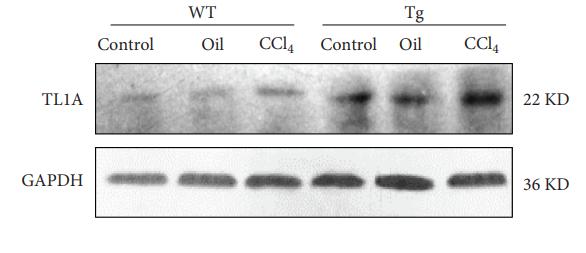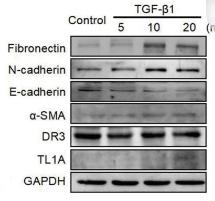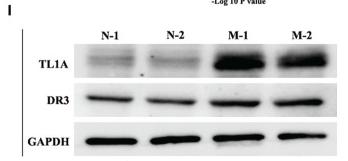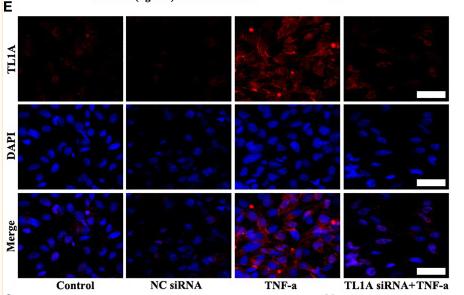TNFSF15 Antibody - #DF3053
| 製品: | TNFSF15 Antibody |
| カタログ: | DF3053 |
| タンパク質の説明: | Rabbit polyclonal antibody to TNFSF15 |
| アプリケーション: | WB IF/ICC |
| Cited expt.: | WB, IF/ICC |
| 反応性: | Human, Mouse |
| 予測: | Pig, Bovine, Horse, Sheep, Rabbit, Dog |
| 分子量: | 20 KD; 28kD(Calculated). |
| ユニプロット: | O95150 |
| RRID: | AB_2835436 |
製品説明
*The optimal dilutions should be determined by the end user.
*Tips:
WB: For western blot detection of denatured protein samples. IHC: For immunohistochemical detection of paraffin sections (IHC-p) or frozen sections (IHC-f) of tissue samples. IF/ICC: For immunofluorescence detection of cell samples. ELISA(peptide): For ELISA detection of antigenic peptide.
引用形式: Affinity Biosciences Cat# DF3053, RRID:AB_2835436.
折りたたみ/展開
MGC129934; MGC129935; TL1 A; tl1; tl1a; tnf ligand related molecule 1; TNF ligand-related molecule 1; tnf superfamily ligand tl1a; TNF15_HUMAN; TNFSF15; Tumor necrosis factor (ligand) superfamily member 15; Tumor necrosis factor ligand superfamily member 15; Tumor necrosis factor ligand superfamily member 15, secreted form; Vascular endothelial cell growth inhibitor; Vascular endothelial growth inhibitor 192a; Vascular endothelial growth inhibitor; vegi; VEGI192A;
免疫原
A synthesized peptide derived from human TNFSF15, corresponding to a region within C-terminal amino acids.
Specifically expressed in endothelial cells. Detected in monocytes, placenta, lung, liver, kidney, skeletal muscle, pancreas, spleen, prostate, small intestine and colon.
- O95150 TNF15_HUMAN:
- Protein BLAST With
- NCBI/
- ExPASy/
- Uniprot
MAEDLGLSFGETASVEMLPEHGSCRPKARSSSARWALTCCLVLLPFLAGLTTYLLVSQLRAQGEACVQFQALKGQEFAPSHQQVYAPLRADGDKPRAHLTVVRQTPTQHFKNQFPALHWEHELGLAFTKNRMNYTNKFLLIPESGDYFIYSQVTFRGMTSECSEIRQAGRPNKPDSITVVITKVTDSYPEPTQLLMGTKSVCEVGSNWFQPIYLGAMFSLQEGDKLMVNVSDISLVDYTKEDKTFFGAFLL
種類予測
Score>80(red) has high confidence and is suggested to be used for WB detection. *The prediction model is mainly based on the alignment of immunogen sequences, the results are for reference only, not as the basis of quality assurance.
High(score>80) Medium(80>score>50) Low(score<50) No confidence
研究背景
Receptor for TNFRSF25 and TNFRSF6B. Mediates activation of NF-kappa-B. Inhibits vascular endothelial growth and angiogenesis (in vitro). Promotes activation of caspases and apoptosis.
Membrane>Single-pass type II membrane protein.
Secreted.
Specifically expressed in endothelial cells. Detected in monocytes, placenta, lung, liver, kidney, skeletal muscle, pancreas, spleen, prostate, small intestine and colon.
Belongs to the tumor necrosis factor family.
研究領域
· Environmental Information Processing > Signaling molecules and interaction > Cytokine-cytokine receptor interaction. (View pathway)
参考文献
Application: WB Species: Mouse Sample: lung tissue
Application: IF/ICC Species: Mouse Sample: Beas-2B cells
Application: WB Species: Human Sample: bronchial epithelial cells
Application: WB Species: mouse Sample: liver tissues and macrophages
Restrictive clause
Affinity Biosciences tests all products strictly. Citations are provided as a resource for additional applications that have not been validated by Affinity Biosciences. Please choose the appropriate format for each application and consult Materials and Methods sections for additional details about the use of any product in these publications.
For Research Use Only.
Not for use in diagnostic or therapeutic procedures. Not for resale. Not for distribution without written consent. Affinity Biosciences will not be held responsible for patent infringement or other violations that may occur with the use of our products. Affinity Biosciences, Affinity Biosciences Logo and all other trademarks are the property of Affinity Biosciences LTD.





